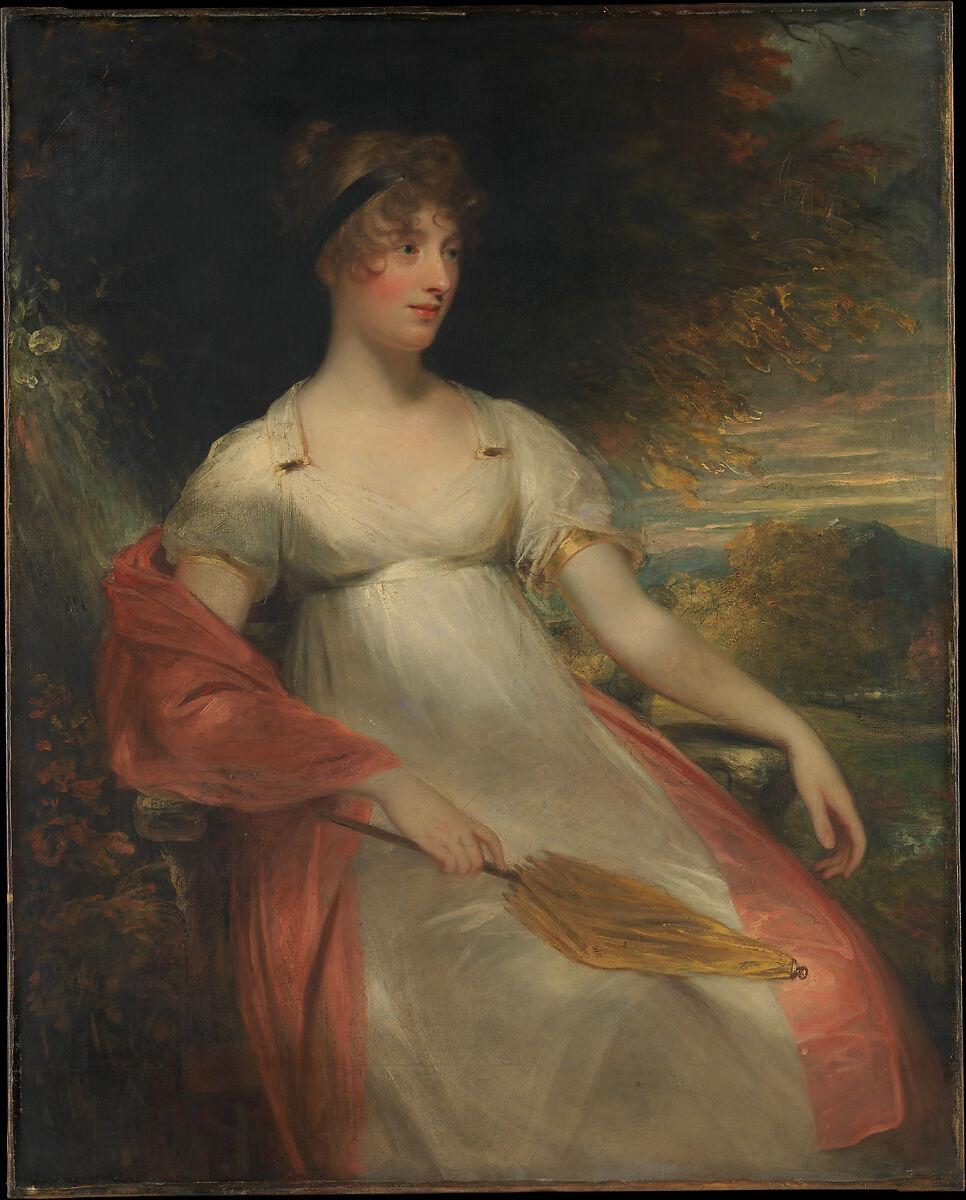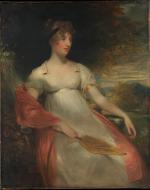Created by Cynthia Honeycutt on Mon, 10/07/2024 - 10:22
Description:
In Jane Austen’s time, there was a very distinct fashion of women that displayed both class and elegance through fabric, color, and variability. In William Beechey’s “Portrait of a Women,” he displays what would have been the ideal fashionable women of status in Jane Austen’s time period. The women painted is wearing a muslin white gown with golden-yellow accents, a silver sash highlighting the era’s signature empire waist, a red shawl draped across her arms, and a yellow parasol perched in her lap. Her complexion is pale, and beauty is natural with her hair in pin-curls and up with a ribbon. The pure white muslin gown is the highlight of regency fashion as white is “fashionable and elegant only when pristine,” as it displays that the women are able to keep a white dress pristine and muslin is an incredibly expensive imported fabric from India (Hafner-Laney). All of these details from the fabric of the gown to its color to her complexion and accessories display that she is a wealthy woman of status.
Though the woman in the portrait is depicted in evening wear, or “full dress,” which was the highest form or regency fashion, women had multiple types of dresses they would wear for everyday use. Both Austen and regency societies use three common terms to describe different stages of dress throughout the day. “Undress” refers to the more practical dress of the home and in the morning, such as dressing gowns, morning dress, and dresses worn around the home (Davidson; Burkard). “Half dress” refers to more informal afternoon or evening wear afternoon activities such as visiting, promenade, carriage rides, or shopping (Davidson). “Full Dress” is reserved for special occasions when a full ensemble is worn such as a ball, fancy dinner, opera, or royal court appearance (Burkard). The different stages of dress lend to the time as it was common for women to only have a few dresses that needed to be versatile and adaptable to different stages of dress (Hafner-Laney). Due to the dresses needing to be durable and last, it was common for women in the family to mend the wardrobe for the stake of longevity no matter the class (Buermann). This also lends to the idea that the more pristine, pastel and light-colored dresses a women owned, the wealthier she was perceived as she is able to keep the dresses clean. In order to keep up with the latest fashions, it was common for ladies who lived in London to be the messenger of new trends to their family in the country so they could adjust their clothes accordingly for the new season (Hafner-Laney). Though the fashion of the regency era may appear simple, it took a lot of work to be considered a fashionable women in Jane Austen’s time.
Work Cited
Beechey, William. “Portrait of a Woman,” The Metropolitan Museum of Art , 1805, www.metmuseum.org/art/collection/search/435632 .
Buermann Wass, Ann. ““I Am the Neatest Worker of the Party”: Making and Mending the Family’s Wardrobe» JASNA.” Jasna.org, 2015, jasna.org/publications-2/persuasions-online/vol36no1/wass/. Accessed 16 Oct. 2024.
Burkard, Linore Rose. “Undress, Half Dress, Full Dress: Making Sense of It All.” Jane Austen Centre and the Jane Austen Online Gift Shop, 2011, janeausten.co.uk/blogs/womens-regency-fashion-articles/undress-half-dress-full-dress-making-sense-of-it-all.
Davidson, Hilary. Dress in the Age of Jane Austen. Regency Fashion. New Haven, Yale University Press, 2019.
Hafner-Laney, Mary. ““I Was Tempted by a Pretty Coloured Muslin”: Jane Austen and the Art of Being Fashionable.” Persuasion, vol. 32, no. 1, 2012.
Copyright:
Associated Place(s)
Part of Group:
Featured in Exhibit:
Artist:
- Sir William Beechey


